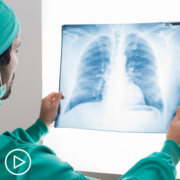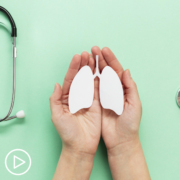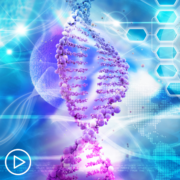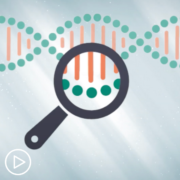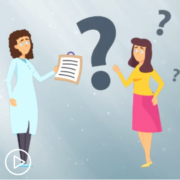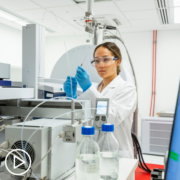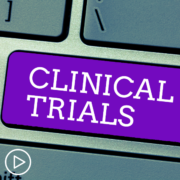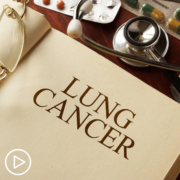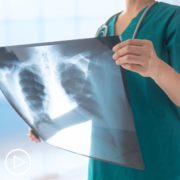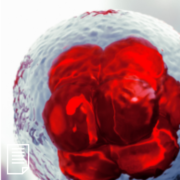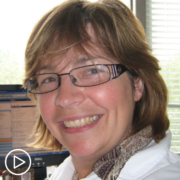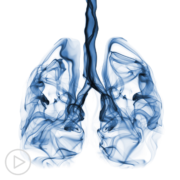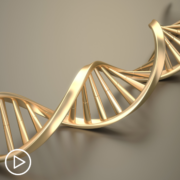HCP Roundtable: Overcoming Lung Cancer Biomarker Testing Challenges from Patient Empowerment Network on Vimeo.
The lung cancer field continues to experience tremendous growth in precision medicine. Oncologists have more tools to treat lung cancer, but access and language remains a big factor in biomarker testing. Drs. Jessica Bauman and Lyudmila Bazhenova discuss current issues in NSCLC biomarker testing, insights on how providers can explain biomarker testing to their patients and their families, and how academic centers and community physicians can work together to overcome challenges in biomarker testing.
See More from Lung Cancer | Empowering Providers to Empower Patients
Download Guide
Related Resources:
Transcript:
Dr. Nicole Rochester:
Welcome to the Empowering Providers to Empower Patients or EPEP program. I’m Dr. Nicole Rochester, a pediatrician and the founder of Your GPS Doc. In this unique program, we connect leading lung cancer expert voices to discuss enhancing physician patient communication and share decision making in lung cancer care. Some of the questions we’re going to talk about today include, what are the major successes and challenges around biomarker testing? How can experts in academic settings work with those in community settings to overcome challenges in biomarker testing? And also, what are the best practices for discussing and explaining biomarker testing to your lung cancer patients?
Thank you. I’m thrilled to be joined today by noted lung cancer medical oncologist, Dr. Jessica Bauman from Fox Chase Cancer Center in Philadelphia, and Dr. Luda Bazhenova from UC San Diego Medical Center. Thank you both for joining us in today’s round table.
Dr. Jessica Bauman:
Thanks for having us.
Dr. Lyudmila Bazhenova:
My pleasure should be here as well.
Dr. Nicole Rochester:
Thankfully, research in lung cancer is ongoing and remains at a fast pace, but with that pace often comes challenges of keeping everyone up to date, providers included. So we have a lot to cover today. So I want to start by just providing a general overview of biomarker testing and lung cancer therapy. So I’m going to start with you, Dr. Bauman. Can you discuss some of the general guidelines for…sorry. So I’m going to start with you, Dr. Bauman. Can you discuss existing guidelines for genomic biomarker testing for lung cancer?
Dr. Jessica Bauman:
Sure. I’d be happy to. So genomic and biomarker testing in general has really been at the forefront of many conversations about lung cancer over the course of the last decade or longer, 20 years. Because it has really changed our approach to patient care and individualized the way that we treat and make decisions about patients with lung cancer. And so what this means, is for every single person who has a new diagnosis of lung cancer, essentially everybody is now recommended to have molecular testing on their individual tumor samples to help us decide what treatment decisions are the best for them. Now, it used to be that this was really only recommended for patients with a new diagnosis of metastatic lung cancer, but now we’re seeing this really influenced decision-making earlier on than the metastatic setting.
And so we now have treatment approaches that change based on molecular testing for early stage one cancer as well. And so, although it used to be more of a later stage, necessity, now we really…we really now need the information sooner than ever before. And when we say molecular testing, this is really looking at the individual tumor and what is potentially driving the cancer to grow. So to look for oncogenic drivers that change treatment. So I call this with my patients, I call this the alphabet soup. But this includes, EGFR mutations, ALK, ROS1, RET, HER2 as well as many others that influence the potential treatment options that we have for our patients.
Dr. Nicole Rochester:
Awesome, thank you. That is a great overview. Do you have anything to add to that, Dr. Bazhenova?
Dr. Lyudmila Bazhenova: No, I think that was very nicely summarized. I think an important thing is that we have to test, we cannot guess. We have to know what our patients…what mutations our patients have, and then we have to know what to do with that. That’s kind of a second part of the question.
Dr. Nicole Rochester:
Wonderful. So it sounds like this is really kind of revolutionary in the sense that, like you said, we can now provide very individualized treatment for lung cancer patients. So I’d love for the two of you to talk about some of the successes in testing over the past decade for lung cancer patients. And we’ll start with you this time, Dr. Bazhenova.
Dr. Lyudmila Bazhenova:
I think our successes actually became our challenges. We have seen an explosion of targetable oncogenic drivers. If you look at the FDA approvals for oncogenic driven therapy, we have a first approval in 2004 and then there was kind of a silence for almost a decade. And then starting in 2014, every year we now have three or four drugs approved. And also those drugs are being approved for the same indication, but different companies. So I think it is very hard for a practicing oncologist who have diseases other than lung cancer to actually keep up with exploding information that they need to know. And I think that’s why I say our success is our challenge, our success is that we are now in lung cancer have 10 oncogenic drivers that we have treatment for.
Our challenge is to remember that there are 10 oncogenic drivers. It’s becoming even more complicated because if you take, for example, an EGFR story, we don’t just need to know that the patient has an EGFR mutation. We need to know what type of EGFR mutation we have, that patient has. And it is no longer three categories. Like even looking in atypical mutations, we now separate out so-called pack mutations, which are treated differently than anything else. So it’s difficult for a practicing physician, or mid-level practitioner to remember what even to do for lung cancer, but they have to do a breast cancer and colon cancer and everything else. So it is a challenge currently.
Dr. Nicole Rochester:
I appreciate you highlighting that. A lot of times it’s like a double-edged sword, right? What are your thoughts, Dr. Bauman, and in terms of the successes as well as some of the challenges?
Dr. Jessica Bauman:
So I absolutely echo what Dr. Bazhenova is saying in terms of the amazing successes, right? We now have for multiple different populations, we have an oral medication that can treat their cancer with the hope that it keeps that cancer under control for many, many months and for some people even years. And I think the challenge is absolutely keeping track of all of those different mutations and then what is actually targetable. And if you have, is it a mutation? Is it a fusion? Is it… What exactly is it that allows you to then use that targetable therapy? Is certainly one challenge. The other challenge is getting that information as soon as we can get it. So you can imagine, so somebody comes in to see me with a new diagnosis of metastatic lung cancer, right? Their biopsy was done say two weeks at a different hospital, and their first scan was done six weeks ago.
So now they’re already six weeks into the concern of a diagnosis of lung cancer, and they’re symptomatic and they come to see me and say, what am I going to do? And we have to get all of that information as fast as we can, because it completely changes the way we’re going to treat them. And so creating systems, in particular reflex testing systems such that this is sent immediately so that by the time they’re seeing me we already have this information is really important. But that, I think that is sort of at its infancy. At Fox Chase, we’ve worked on our sort of reflex system for a very long time. And it’s still, every time there’s a new approval, it seems like it changes slightly or there’s a new system that we have to think about it. But at the end of the day we also…one of the challenges is making sure that we streamline the processes in which we get this information in the best way we can because tissue can be limited.
There is a lot, making sure that you actually get adequate tissue sampling to be able to test for everything that you need to test for is really important. Then figuring out where to send the testing. Many academic centers have internal panels that they send for molecular testing, but there are so many different companies that advertise doing some kind of molecular testing. And so knowing which of those companies to consider using, what they’re offering, which ones offer RNA sequencing, for example, because that is a particularly important aspect, in addition to DNA sequencing that we need. And so sort of keeping track of all of that is particularly challenging. And then I think the last thing is, I think it’s the needing this information earlier and earlier in a diagnosis.
Dr. Jessica Bauman:
And so once upon a time, it really was the medical oncologist who could drive this and run the show because it was really, we needed it for somebody with metastatic disease, right? And we’re sort of the captains of the ship per se, when someone has a new diagnosis of metastatic disease. However, now there’s adjuvant therapy for patients who have EGFR mutations after a surgical resection. And so we need, the surgeons also need to really understand that we need this information. And they often are now getting these tests before a medical oncologist even sees the patients. And so it isn’t just medical oncology, it’s also now, it’s going into multiple different specialties who also need to understand what these mutations mean and what to do about them, and then how it influences therapies.
Dr. Nicole Rochester:
Wow, you all have really done such a great job highlighting both the successes and the challenges. And it’s a perfect segue into my next question because you just alluded to, Dr. Bauman, this idea of academic medical centers and the challenges that you all are facing in cancer centers. And we know that many patients are receiving their care in the community, and in fact, sometimes it’s this dichotomy between what happens in the academic setting and the community setting that can actually create and perpetuate disparities. So my next question really has to do with how can lung cancer experts in academic settings partner with, collaborate, work with those experts in the community settings to overcome some of these challenges that you all just talked about as it relates to biomarker testing? So I’ll start with you, Dr. Bauman.
Dr. Jessica Bauman:
So, that’s a million dollar question. I do think there are many opportunities of educational opportunities to continue to educate everybody in terms of lung cancer. I think lung cancer is a very common diagnosis. And so we know that many community providers absolutely deliver excellent lung cancer care. And so making sure that there are many opportunities for them to participate in, either citywide or nationwide educational opportunities for updates on lung cancer. We have in Philadelphia, we actually have an academic, sort of a multi-multidisciplinary, multi-institutional tumor board, thoracic tumor board that happens quarterly, which we invite community providers to to discuss some of the latest literature. Certainly our emails are always available, so we can always bring there, certainly we get many different questions that come in from other providers, but I’m sure we could do a better job. And I’m very curious to hear what Dr. Bazhenova thinks about this as well, because I think it is such a huge challenge.
Dr. Lyudmila Bazhenova:
I agree with you fully, and I think my two cents here is I think we have to recognize and accept that one size does not fit all in this situation. And whatever works for my institution is probably not going to work for a smaller community practice. But as long as we recognize that this needs to be done and each community practice can work with their stakeholders in the molecular testing pathway, like molecular pathologists, regular pathologists, surgeons. Each institution has power to establish their own internal pathways. Would it be what Dr. Bauman says, reflex testing, which is probably not going to be an option for a majority of the community setting because they do not have their own NGS. It’s going to be a sendout. Or like in our institutions, we don’t have a reflex molecular testing. It’s us medical oncologists who are ordering it, but we kind of get it on the backside.
We can get the patient in within 24, 48 hours from the consult was put in. And so that’s why we didn’t do the reflex testing, but as the reason we did it is because we sat down as a team and we decided this is what works for us. So I encouraged the community groups again, sitting down saying, okay, the task in hand is lung cancer patient has to have molecular testing at the time of the diagnosis. How are we going to get it and how are we going to make sure that we are not missing, you know, have some kind of internal QI, and make sure you know what your practice is doing rather than assuming that your practice is doing molecular testing for all the patients.
Dr. Nicole Rochester:
Thank you so much. Did you have something you wanted to add, Dr. Bauman?
Dr. Jessica Bauman:
Yeah, I was just going to say, and I think that so many things are happening before they ever see us, that includes a pulmonologist is going in and doing a biopsy, right? Or an interventional radiologist is getting a biopsy. So it has to start way upfront of the actual diagnosis because the, what you want to try to get to capture the information as soon as you can, right? So you don’t want to get just an FNA biopsy, for example, of a liver lesion knowing that three weeks later what you really need is a core biopsy, right? So it really, the path you do, it involves so many different stakeholders when you’re having conversations about how to streamline this for your own institution and practice.
Dr. Nicole Rochester:
So both of you have really touched on the challenges even among physician-to-physician communication and the fact that by virtue of the diagnosis and the treatment, there’s lots of different specialists involved, the timing of which can be very crucial. And so shifting to physician patient communication, which we know is fraught with even more challenges. Can you each share some examples from your own practice around improving physician patient communication that may serve as exemplary for providers that are watching this program? And we’ll start with you, Dr. Bazhenova.
Dr. Lyudmila Bazhenova:
I think it also has some challenges, because in the current environment of practicing medicine, we are, as physicians, we are pushed to see more patients, it’s all about productivity. So when you do that, something has to give. And a time that we can spend with the patient is limited. And I think it’s important, for myself, as a practice, I have the same, I call it spiel that I give to all my patients. It’s the same picture I write down when I speak and I give that paper to the patients. I’ve had, you know, created some preprinted things that I used to give to the patients. Don’t do it anymore. But I think that’s another thing, have some kind of information that is a patient level that I can give to the patients.
And I think we have to educate the patients as well, either by ourselves or using the platforms that we are exhibiting here, that is outside of our primary institutions. And to make sure that the patients are aware that each one of them who have a stage IV lung cancer, as well as early stage lung cancer needs to be tested for the molecular testing. And kind of put it also have the patient question the physician, did you do that? Was that test done? That’s one part of information. And I think the second part is, we do have to do better in allowing our patients to get a faster access to us. And we kind of accept the fact that we are going to be working after hours. When the clinic is over, that’s where I’m going to go to my charts, and I’m going to answer my patient’s question.
It’s kind of an intrinsic, is the work of the physician. Hours is…unfortunately, doesn’t really count. There is no limit to that. So whatever it works, like having a nurse educator. We have in our institution, we have…we call her tissue coordinator, but she’s the person who can actually make sure that the tissue is done, she can also make sure that reports are sent to the patient and make sure that patient has ability to ask questions of somebody. And I think the EMR, electronic medical record, it’s kind of a love-hate relationship, I think, with all of us. But one thing that I find it made it much easier for me is to communicate with my patients using my chart and this ability to release the result to the patient by one click of a button, that saves time for me so I can spend that time to actually visit the patient and explain to the patient what needs to be done.
Dr. Nicole Rochster:
That is awesome, thank you. Do you have anything to add, Dr. Bauman?
Dr. Jessica Buaman:
In terms of challenges of discussions with patients?
Dr. Nicole Rochester:
Yeah, and best practices. So Dr. Bazhenova mentioned using portal, which I think is awesome, and really educating patients in a way that allows them to ask questions of their providers. Any other insights or tactics that you use?
Dr. Jessica Bauman:
Yes, yes, I agree that I think that this overall requires a lot of education, and especially when patients come in and they want to know tomorrow or yesterday, actually, what they’re going to get for treatment and what we’re going to start with. And so telling them that actually we still can’t decide for at least another week or two, that in of itself can be challenging. I think the other piece of this that’s always important is, in general, when we’re doing molecular and biomarker testing, we’re looking for changes in the tumor, we’re looking for what we call somatic mutations, but there is also the second concern where on rare occasion, issues with molecular testing can bring up issues with germline testing, meaning some abnormality that’s found that may impact their own familial risk for cancer, and so that of course requires a lot of thought and careful education as well, in addition to the treatment decision-making that we’re really ordering the test to decide upon.
Dr. Nicole Rochester:
Really good point. Because if there’s a familial aspect, like you said, that brings up an entirely another layer of discussion and worry and concern as well. Well, Dr. Bazhenova I know that you lead a weekly tumor board for lung cancer, and I’d love to learn more about some of the things that you can share that may be insightful for other lung cancer experts as a result of the tumor board.
Dr. Lyudmila Bazhenova:
At UC San Diego, we actually have two tumor boards where lung cancer patients can be presented, one is just a traditional multidisciplinary thoracic tumor board, which is attended by a medical oncologist surgeons, radiation oncologist, pathologist, interventional people, clinical trial coordinators. And I think this is not unique to UC San Diego. The multidisciplinary tumor boards are available in all major academic institutions. And I think lung cancer care is becoming more and more multi-disciplinary, especially with the new advances of new adjuvant to chemo immunotherapy and controversies we still have to this point in management of stage three disease. And I think what I find in a multidisciplinary tumor board…
Because I think what I want to build upon as Dr. Bauman statement that she said that times of an essence here, and I think the multi-d tumor board help us make medical decisions on the spot rather than me sending a patient to see a surgeon or sending a patient to see radiation oncologist and sending patients to see interventional radiologist, and then the IR is telling you, “Oh, we can’t do that biopsy, you gotta send it to the pulmonologist.” I think that actually streamlines the patient care. The second tumor board what we have, that maturity of the lung cancer patients actually don’t get presented there, it’s a molecular tumor board. And the reason why we don’t present majority of the lung cancer patients there because management of antigen-driven lung cancer is pretty straightforward.
I think only presentations I would ever make there if they have an unusual mutation that I can’t find any information about, then I need the help of our molecular pathologist, but it is a good avenue for those weird rare molecular abnormalities that I’ve seen in other malignancies and so that is another option. And there’s actually…many institutions have molecular tumor boards as well. We do open our tumor board not to all communities. So we are not as good as you, Dr. Bauman. So only one community practice can join us because they’re kind of part of us, so we don’t usually…we don’t have it open to the whole community, and I think as an academic institution, we probably should strive to have an open tumor boards where everybody can join and listen and present and that’s the most important.
Dr. Jessica Bauman:
I do want to say, we don’t..I must have misspoken, we definitely don’t include community practices. So I do think that that would be a fantastic offering in the sense of some of the… I don’t know that we could do that on a weekly basis, but consider something like on a monthly basis or even a quarterly basis of a true tumor board where people can present cases in real time from community practices.
Dr. Nicole Rochester:
Awesome, yeah, I think based on everything that you all have shared, that would definitely be an added benefit for sure. So circling back to communicating with patients, you all have already shared the challenges related to productivity and the limited time that we have with patients and some of the things that you have been able to institute. I wonder if either of you or both of you have any thoughts around unique things that you’ve implemented that have allowed you to really connect and communicate with your patients in spite of these time limitations. So I know we talked about using the portal, which is an amazing resource. Are there any unique things that you all have implemented in real time, like face-to-face, when communicating with patients?
Dr. Jessica Bauman:
So I would say we did a pilot study that has not been implemented full time, and really I think we’re still working on how to best implement something like this but we did a pilot study using sort of educational materials, and this whole sort of pathway and educational system in coordination with our nurse navigators, where you could send sort of a prescription to the patient of reading material or of educational material, as they’re going along. And so, with the idea that early on that one of those prescriptions would be more information about molecular testing and biomarker testing, decision making, all of those types of things.
We did a small pilot study to incorporate that, which on the surface is fantastic but it was surprisingly challenging to do, to actually implement. And I think that was…we were doing this, again, in collaboration with one of the researchers, the nurse researchers at our institution, and we hit more barriers than expected, because I think we all, as you say, we all want to educate, we all want to make sure that our patients understand and get the information that they need, but the practicality of doing that really successfully and in a streamlined way but that’s also consistent across providers across the institution, it’s a challenge.
Dr. Nicole Rochester:
Yeah, I can imagine. Are there a chance to extend the pilot or to maybe modify it based on what you all learn from the initial study?
Dr. Jessica Bauman:
I think that that’s… It’s certainly in discussion about how to best implement something like this. Part of that is… Again, sort of systems change. The role of the clinic nurse, the nurse navigators has changed a little bit and so even how we envision implementation is going to need to shift somewhat.
Dr. Nicole Rochester:
Wonderful. What about you, Dr. Bazhenova? Any pilot studies or any other maybe tips and tricks that you employ independently?
Dr. Lyudmila Bazhenova:
Yeah, we haven’t had any pilot studies but I think the more I think about it…so the challenge of discussing those molecular testing with the patients is the fact that majority of those molecular testing discussions happen in stage four patients and majority of those discussions happen during the first visit for a patient with stage four lung cancer where we just discussed that this is an incurable cancer with limited life expectancy. And then how much does our patient actually absorb anything else we said afterwards is still remain to be seen. And I actually have seen like when I talk to the patient because they are so understandably fixated on their prognosis and survival, because it’s going to affect their lives that after that my patient asked me a question that I know I’ve discussed it already because I have my spiel.
I tell the same thing to everybody. And I think now kind of thinking about it out loud after that, during that discussion and maybe we could set up another appointment with a nurse practitioner afterwards, that after the patient kind of already digested all that information, to go over again the management of the molecular abnormalities. And one thing I actually want to highlight and build upon something that Bauman said before, that in those patients we actually usually wait for the molecular testing to come back before we start their therapy. And it is much easier to just prescribe chemotherapy immunotherapy for those patients.
But then you’re going to run into issues of toxicity because if you gave immunotherapy before you give for example EGFR TKI and some ALK TKIs, you can actually going to run into toxicity and you can permanently prevent your patients from continue on tyrosine kinase inhibitors. And so that’s why this is an information that not all oncologists, especially those who practice in a tobacco belt where they don’t see a lot of oncogenic driven patients, they might not be aware of that. And I think how do we pass that information to the physicians, and also how do we pass that information to the patients that there is an easy way, but easy way in this situation is not the right way?
Dr. Nicole Rochester:
Wow, so many competing priorities. This has been a fascinating conversation. It’s time for us to wrap up but I really want to thank both of you for offering your insight and your expertise. And I’d love to get some closing thoughts. We’ve shared, you all have shared so much about the challenges, as well as the successes, you’ve offered some insight into some things that can probably be further developed in the future. So as we wrap up, I’ll start with you, Dr. Bauman, what are some closing thoughts that you would share with the providers that are watching this program?
Dr. Jessica Bauman:
I think I would again highlight just how imperative it is to create systems early on to identify how you’re going to get molecular testing on all of your lung cancer patients, and then have a good tracking system to make sure that it’s incorporated in your notes that you have potentially a database within your practice, so that you really are aware of the different molecular abnormalities that your patients have and then potential treatment options that they have later. And that to understand that this really is a multi disciplinary approach where everybody needs to understand the importance of adequate tissue, and how it can influence decision-making, even now with somebody with a stage one lung cancer.
Dr. Nicole Rochester:
Thank you so much. What about you, Dr. Bazhenova?
Dr. Lyudmila Bazhenova:
I fully agree with Dr. Bauman. So the one thing, kind of to add upon, as we’ve talked about before that molecular abnormalities and lung cancer becoming very complex NTRK point mutations is not the same thing as NTRK fusion. One responds to NTRK therapy and the other does not. And for every physician, you know what, if you’re using the molecular testing companies outside of your own institutions, just be aware that that molecular testing company does have a molecular pathologist on staff that you can actually talk to, and they do respond and they do reply. So if you have a mutation that you’re like, “I don’t know what that is.” Pick up the phone and call that company and they will be very, very happy to discuss the mutation with you and just highlight what is an appropriate treatment for that patient.
Dr. Nicole Rochester:
Thank you. Thank you both so much. Just to summarize, I mean, I have learned a lot which I always do in these programs, and to summarize, you all have spoken about the importance of biomarker testing, the evolution of testing and the importance and how it’s used now for not just late stage but early stage cancer. You’ve talked about the complexities associated with biomarker testing and really the need to fully adopt a multidisciplinary approach, not just as it relates to diagnosis and treatment, but even as it relates to communicating with patients and bringing in those nurse educators and those navigators and making sure that we take a multidisciplinary approach.
And you’ve also shared some insight about tips for communicating with patients, despite the time limitations that we face in the clinical environment and so I’m just really thankful for your time today. Really grateful for your expertise, and I want to thank all of you for tuning into this Empowering Providers to Empower Patients program. Have a wonderful day.
Dr. Jessica Bauman:
Thank you.
Share Your Feedback About the Program

